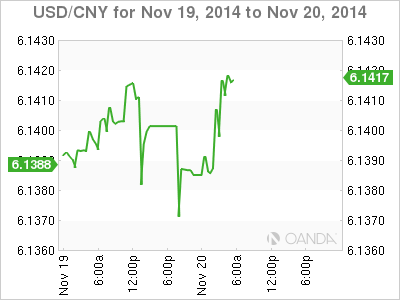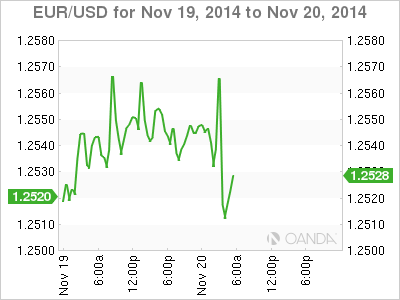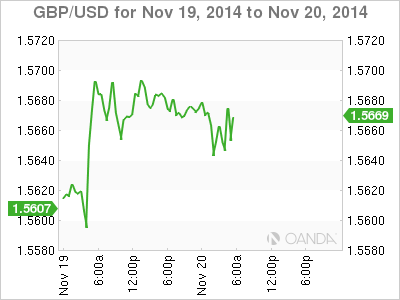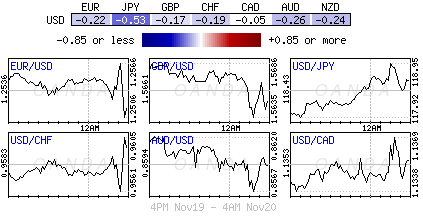Fed reinforces “normalization”
China flash manufacturing PMI dips to 6-month low
Weak Flash numbers has EUR hobbling
Fed announcements usually end up having the largest market impact, and yesterday’s FOMC October minutes were trying not to be “the” exception. Nevertheless they seem to have failed, ending up be “non-event” as currency prices remain contained in limbo status range looking for a meaningful impetus.
The minutes from last month’s critical meet, when the Ms. Yellen and company formally concluded their QE3 program, again reinforced market expectations for the beginning of “normalization” of policy sometime in the middle of 2015 – which came as no surprise. The Fed now heads the BoE ‘normalcy’ timetable.
Since the release, investors and dealers have witnessed U.S treasury yields backing up a tad (10’s +2.33%), the “mighty” dollar finding some traction, while gold prices attempted to fall into yesterday’s close as U.S policy makers remain mindful of improving both U.S labor conditions and economic growth. Fed members remain concerned that “measures of inflation compensation had declined somewhat” but also added “longer-term inflation expectations had remained stable.”
The markets conclusion is that there is little in the minutes to prevent the latest projections for interest rates despite the uncertain inflation outlook. The market will want to take a closer look at this morning’s US CPI figures for further individual clarity.
China flash manufacturing PMI dips to 6-month low
Softer data from the world’s second largest economy continues to worry everyone. The leading assessment of China’s economy this month via the HSBC flash manufacturing PMI was not particularly impressive as the index missed estimates to hit a six-month low of 50.0 (on the cusp of expansion/contraction divide). The reading is the latest evidence that the world’s second biggest economy continues to lose traction.
Digging deeper amongst the most notable components:
Chinese employment deteriorated at a faster rate
Output turned to expansion from contraction
Export orders increased slowly
While input prices decline receded
On the first go around, economists note that Chinese “disinflationary” pressures remain strong, capacity utilization point to insufficient demand in the economy, and more monetary and fiscal easing measures are justified given the “significant downward pressures” on growth. Reports like this will weigh on regional commodity sensitive currencies (NZD and AUD). China remains the Aussies largest trading partner and until Australia manages to change their business mix (relying too heavily on commodities extraction/production), they will always be one of the most susceptible to Chinese growth worries. The AUD has eased against the greenback on the news, trading at AUD $0.8607.
Weak Flash numbers has EUR hobbling
The 18-member single currency’s fragility is once again highlighted by this morning’s economic data. With another disappointing report, perhaps the EUR bear may want to consider holding off booking profits just yet?
The single currency squeeze to its recent lofty heights (€1.2540-70) is trying to be reversed by some poor regional reported PMI’s. The Eurozone’s November composite PMI came in at 51.4 this morning vs. the 52.3 consensus and worse than last months 52.1 print. Data like this would suggest that only +0.1-0.2% GDP growth for Euro Q4. The initial currency price action was rather choppy and to be expected on the back of French manufacturing and services remaining in contraction and with Germany’s 50 neither expansion or contraction print.
The eurozone weakness highlights the fragile and uneven growth and certainly helps to keep ECB easing very much in play. Some dealers will try to shift gears and expect to see a more proactive ECB over the coming months. Will Euro policy makers be capable of sweetening Decembers TLTRO program (long-term refinancing operation) in a fortnight? There is a strong chance of full-blown QE in Q1 2015, but Draghi needs to convince the Germans.
To date, the ECB has had the minimum of success in expanding its balance sheet. In fact, it has actually declined -€11b since the beginning of September. The EUR will remain very sensitive to short interest rate trends, with further downside very much on the cards. However, be mindful of the Swiss “floor.”
This morning’s U.K October retail sales (+0.8%, m/m and +4.3% y/y) handily beat expectations. Unfortunately, it was driven by the steepest fall in store prices as the price deflator registered its sharpest decline (-1.5%) in a dozen-years. It’s not a surprise to see that the fall was led by petrol stations, backed by plummeting crude prices this year.
On the plus side, the BoE’s Governor Carney will be happy to see the U.K consumer, who are the main driver behind U.K growth, are willing to keep spending. Many had feared that a fall in wages would have a material negative impact, obviously not yet.
Cable has risen; further backing away from its 14-month lows on the strong October sales headline. It’s trying to take out the Asian overnight high, but seems to be lacking the stamina at the moment. There are market touted offers at £1.5700 (near yesterday’s London high) and £1.5720 (post-FOMC minutes high).
This article is for general information purposes only. It is not investment advice or a solution to buy or sell securities.
Opinions are the authors — not necessarily OANDA’s, its officers or directors. OANDA’s Terms of Use and Privacy Policy apply. Leveraged trading is high risk and not suitable for all. You could lose all of your deposited funds.
Recommended Content
Editors’ Picks
AUD/USD stands firm above 0.6500 with markets bracing for Aussie PPI, US inflation

The Aussie Dollar begins Friday’s Asian session on the right foot against the Greenback after posting gains of 0.33% on Thursday. The AUD/USD advance was sponsored by a United States report showing the economy is growing below estimates while inflation picked up. The pair traded at 0.6518.
EUR/USD faces a minor resistance near at 1.0750

EUR/USD quickly left behind Wednesday’s small downtick and resumed its uptrend north of 1.0700 the figure, always on the back of the persistent sell-off in the US Dollar ahead of key PCE data on Friday.
Gold soars as US economic woes and inflation fears grip investors

Gold prices advanced modestly during Thursday’s North American session, gaining more than 0.5% following the release of crucial economic data from the United States. GDP figures for the first quarter of 2024 missed estimates, increasing speculation that the US Fed could lower borrowing costs.
Bitcoin price continues to get rejected from $65K resistance as SEC delays decision on spot BTC ETF options

Bitcoin (BTC) price has markets in disarray, provoking a broader market crash as it slumped to the $62,000 range on Thursday. Meanwhile, reverberations from spot BTC exchange-traded funds (ETFs) continue to influence the market.
US economy: Slower growth with stronger inflation

The dollar strengthened, and stocks fell after statistical data from the US. The focus was on the preliminary estimate of GDP for the first quarter. Annualised quarterly growth came in at just 1.6%, down from the 2.5% and 3.4% previously forecast.



